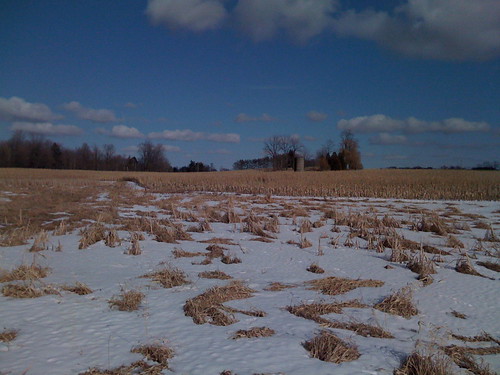
High on my long list of Spacing posts I’ve not yet had time to make is one on Richard Serra’s “Shift” sculpture. It sits in a field near King City, north of Toronto. As of today I no longer have to make the post because Derek over at BlogTO wrote an excellent piece on it. When Spacing Review’s editor Jessica Duffin Wolfe and I went out to see Shift on a sub-zero Sunday afternoon last February, the future of this crazy-wonderful piece of art was unclear. However, as the Globe reported a few days ago, it’s future may be secure. Derek at BlogTO writes:
“Shift” is challenging in the way that almost all good modern art is. It doesn’t reveal its meaning or its beauty quickly. But given the chance to dwell upon it for a while, it’s impossible not to acknowledge the seamlessness by which it’s incorporated into the landscape. In speaking of his intentions for the installation, Serra reveals that what he “wanted was a dialectic between one’s perception of the place in its totality and one’s relation to the field as walked. The result is a way of measuring oneself against the indeterminacy of the land.”
Though Serra’s work has at times been termed monolithic, nothing could be further from the truth here. Not only is the boundary of “Shift” defined by the “maximum distance two people [can] occupy and still keep each other in view,” but the structure also emphasizes the natural curvature of the terrain, rising and falling in direct proportion to the land itself. Its scale is thus determined by a sort of parallax effect, whereby the most distant reaches of the sculpture blur with the land.
“Shift” is also a profoundly human structure. The maximum height of each shifting wall is five feet and hence at eye-level. At no point does it ever disregard the viewer or the land. But this human quality also extends beyond the formal elements of the sculpture.
Read the rest of his post. We were also in a bit of a daze when we finally found the sculpture. We knew what to expect but when you see it in person it overwhelms and we visited it for an hour or so before walking back to the car. What follows are photos of our journey to see a snow-covered Shift (part of the motivation of this mini-post is that our fingers froze to the point of pain while taking pictures, so they need a full public viewing to make it worthwhile). One question some of our readers may be able to answer: where is Roger Davidson now, the wealthy art collector who first commissioned Shift in 1970? Google searches only pick up mention of him in stories about Shift (proving the only way to hide from Google is to have done things before, say, 1993). Beyond checking the links in BlogTO’s post, pick up a copy of Coach House’s 2007 book Concrete Toronto and read a short essay on Shift by Toronto artist and architect Adrian Blackwell.
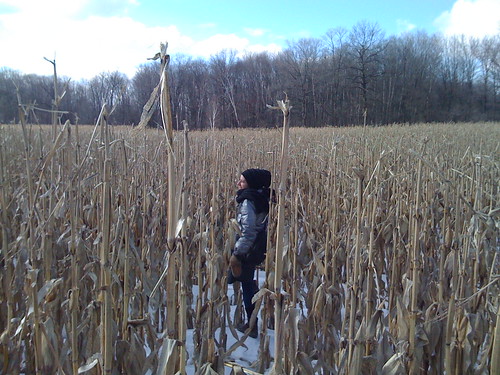
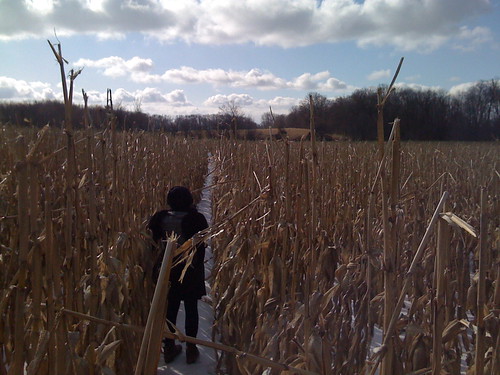
Jessica and I walk through the crunchy snow and winter corn to Shift’s back field site. We discover walking through corn is inherently spooky. Especially frozen, crunchy corn.

Shift comes into view. “There is is,” we said aloud.
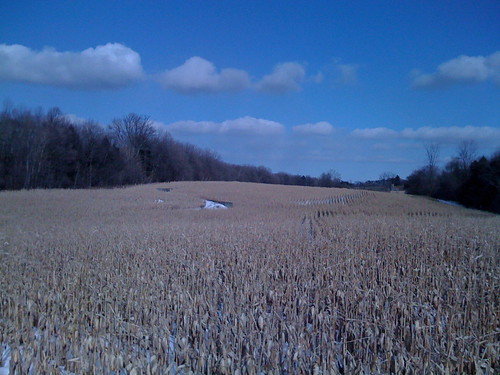
Our photos are a nice contrast to the ones on BlogTO, where the crops had been harvested. Shift was shiftier surrounded by the corn, and even more subtle when viewed from a distance. Whoever the farmer is, he or she is good with a combine, as we couldn’t see any obvious collision sites despite planting so close to the piece.

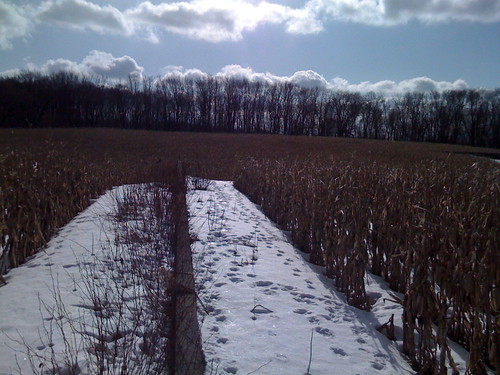



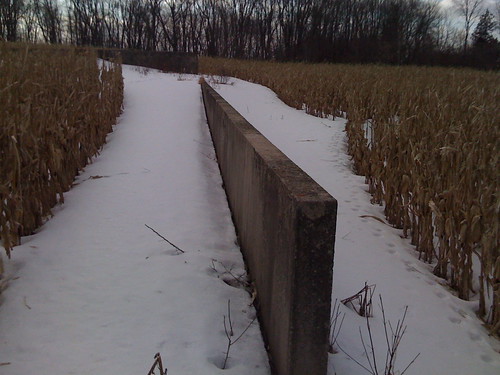
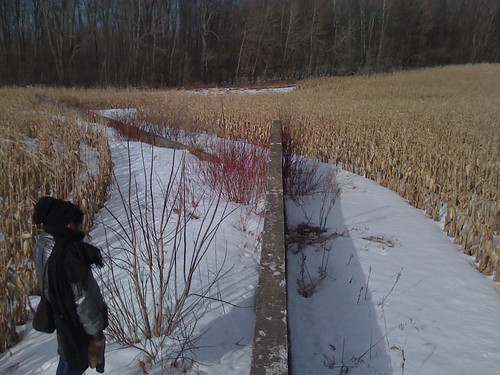
A thin layer of moss is a natural patina. As a lover of concrete buildings — especially brutalist ones — Shift is like the ultimate expression of why I like them: they relate so well to the natural landscape (see the Ontario Science Centre crawling down its ravine or U of T’s Scarborough campus on top of Highland Creek ridge).

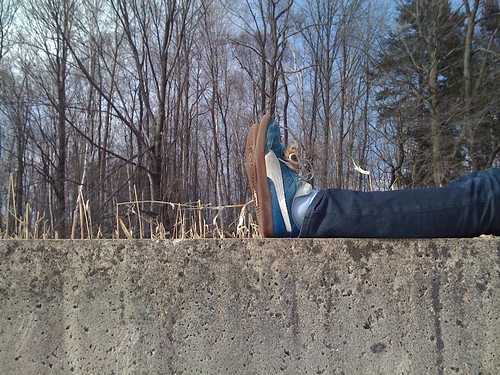


$7 million art that you can sit on. Not for long though, too cold. One of the most peaceful and fulfilling hours of the last year by far.


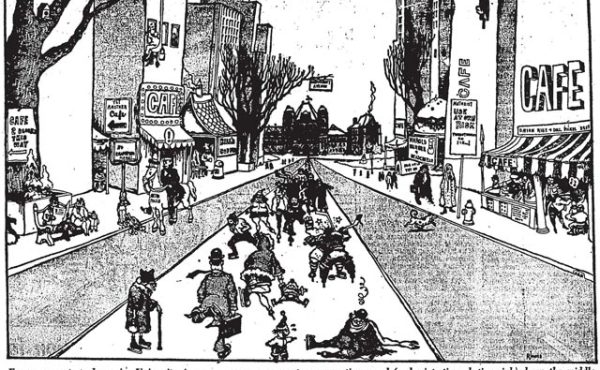
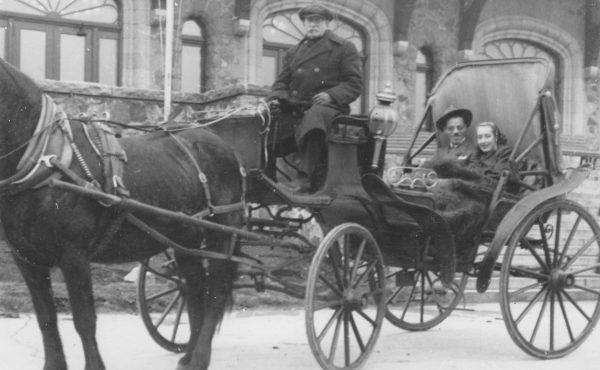
8 comments
When I was researching my piece, I cam across your Flickr set of the above photos. Despite the obvious differences in the weather, it does indeed look like you two had a similar experience. It’s so strange how a subtle concrete apparatus can have such a profound effect.
Thanks for sharing.
Interesting piece – I didn’t know it was there either.
I still think its a shame that he has one other major work in Canada and you have to buy a ticket on an international flight through Toronto to see it. Kind of defeats the purpose of public art.
I’ve been aware of the existence of this piece for years, but I’ve never felt compelled to track it down. I’m not sure why that is. I like to go find things. I once spent an afternoon in Memphis looking for Furry Lewis’ grave, for instance. I suppose it just slipped my mind that the sculpture was there. There is a certain charm about a large-scale sculpture by a world-famous artist existing quietly, with little fuss, out in a farm field.
I suppose now the piece is as much an artifact as a sculpture, given that there has been no effort to maintain it in any way over the years. But now it has been in the news and is back in my consciousness. Perhaps when we see nice weather again, I’ll pack a lunch, tell the dog to hop in the back seat, and we’ll go check it out.
I’ve yet to see Shift myself, but it’s on my list next time I find myself anywhere near that part of York Region.
I do find it a bit odd though, that both of Canada’s Richard Serra’s are in the “905.”
Mike, I’d disagree. While I suppose the “public” componenet is less at Pearson, it’s always a pleasure to find art adding to an experience whether it be in a private, public or grey-space such as Pearson.
Jason Paris, I agree its a pleasure when you find good art in places like the airport, but I also consider it a major disappointment that an impressive piece by an important artist is permanently installed in a location where very relatively few people will ever get to see it.
Art lovers shouldn’t have to take an international flight to visit that work. Shouldn’t it be accessible to anyone who wants to see it?
Umm… It’s a $7 million concrete wall in a corn field? You lost me, and the other 95% who don’t have the taste for that cool aid.
If it’s at 95% the ROM, the AGO, the MOMa et al are in real trouble. But they’re not, so you’re wrong.
hi – i am a huge fan of RS – and I think it is pretty outstanding that we (Torontonians) have one of his works in our reaches. I have been doing a little research into this piece and have found out that the motion to have it designated under the Heritage Act is being appealed/challenged. Is either ROM, AGO or MOMA involved in the conservation of this sculpture? I have been trying to find an Institution or foundation that is involved and keep coming up blank….any pointers would be greatly appreciated! Also – started a Facebook page to help create awareness about Shift. SAVING SHIFT.